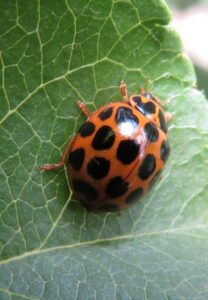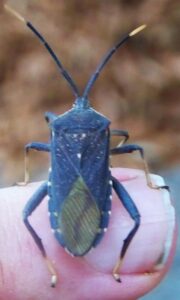Thanks to the people who have contributed to this week’s newsletter: Helen Simpson, Holly Gallagher, Jaimie Sweetman, Lynette Moore, Meg Montague and Olwyn Smiley.
Chinese jujube date (Ziziphus jujuba) by Jaimie Sweetman
[Jaimie Sweetman is Head Gardener of the Edible Forest located on the Yarra Valley Estate in Dixons Creek. There are regular tours of the Edible Forest, often led by Jaimie – read more and book your place on a future tour.]
 The Chinese jujube date originates from China and has been used in traditional Chinese medicine for thousands of years. It is considered to be high in both nutrients and antioxidants.
The Chinese jujube date originates from China and has been used in traditional Chinese medicine for thousands of years. It is considered to be high in both nutrients and antioxidants.
The taste of the fruit resembles an apple yet also a date. Because the harvesting season is only a couple of months, they are often sold dried, and sometimes as candied dried fruit.
The plant is a small, deciduous tree that can get 5-10 metres tall. It enjoys a long hot summer with a cool winter to go dormant in and thus it grows well in southern inland Australia. It fruits in the Autumn.
Our tree is growing in a hot area of the forest that is protected from wind and this year is the first year that we have had fruit. The tree is around 6 years old and has grown quite slowly.
Young trees cost upwards of $130 each from specialty growers.
In summary, this is a unique tree that is worth considering if you have the right spot.
Read about more of Jaimie’s unusual edible plants on our website.
Community garden news
Pentridge Community Garden in Coburg is temporarily re-locating to a nearby site for the next 2-3 months whilst some construction work is undertaken on the original site.
Question of the week
Question from Judy: I grow my strawberry plants in raised metal veggie beds. The runners are hanging to the concrete path and running along concrete. Do they have to grow and fruit like that or should I cut and plant them?
Answer from Helen Simpson: I’m assuming the runners have cascaded over the top of your metal edged veggie beds and are now running down your concrete path. If you want to make more plants from the runners, you can pin the small plants that have been produced by the runners into pots containing potting mix. Use small wire loops to hold the plants at the top of the potting mix, until they’ve formed their own root system. Once roots have formed, you can cut any runners between the plants, to free them into being their own plant with their own root system.
Another article by Angelo
Read more of Angelo’s food-related articles.
The Melbourne ‘Local Food Connections’ community radio show
On next Sunday’s show (12th May, 10-10.30am), listen to Ann Stanley on 3CR (855 AM) by tuning into either the station (855 AM) or its livestream.
Podcasts of all previous episodes are available on their website, the latest being Georgia Savage on The Community Grocer (5th May).
Insect of the week – common spotted ladybird
[Olwyn Smiley has written in: “ I love the idea of having an ‘insect of the week’ segment! Our gardens are important habitat for insects and other invertebrates as more and more bushland and gardens are cleared in the name of development. I love seeing these little residents and visitors in our patch.“]

 The two photos are both of a common spotted ladybird (Harmonia conformis), with the left hand one being of a juvenile/larva whilst the right hand one is of an adult.
The two photos are both of a common spotted ladybird (Harmonia conformis), with the left hand one being of a juvenile/larva whilst the right hand one is of an adult.
Both adults and larvae are predators, feeding on aphids and the like. The adults always have the same number of spots (20). The larvae have different numbers of orange stripes, depending on their age.
The common spotted ladybird is indigenous to Australia.
Ladybirds are a type of beetle. Beetles, like butterflies but unlike true bugs, undergo complete metamorphosis via pupation from non-flying, non-mating larva to flying, mating adult. Most beetle larvae are much more grub-like than those of the ladybird.
Meg’s mushroom
 Seemingly inspired by my photos of the eucalyptus tip-wilter from last week, Meg Montague has sent in a photo of some mushrooms from her garden. She says that she used the iNaturalist app to get the ID of Psilocybe subaeruginosa. If correct, this is a psychedelic mushroom. If incorrect, however, it could be the similar looking, but highly poisonous, deadly skullcap (Galerina marginata).
Seemingly inspired by my photos of the eucalyptus tip-wilter from last week, Meg Montague has sent in a photo of some mushrooms from her garden. She says that she used the iNaturalist app to get the ID of Psilocybe subaeruginosa. If correct, this is a psychedelic mushroom. If incorrect, however, it could be the similar looking, but highly poisonous, deadly skullcap (Galerina marginata).
Mushroom, plant and animal identification
Given Meg’s input above, I thought it might be useful to summarise my experience in using websites, phone apps and experts to identify mushrooms, plants and animals.
Mushrooms
My experience is limited but I haven’t yet found a reliable way of identifying mushrooms. One problem, both during identification and in subsequent verification, is that different mushrooms look so similar. Another problem is that the gills are often an important identification factor but photographing them without destroying the mushroom is problematic.
Plants
The are lots of plant ID apps for phones, some free and some paid for.
I have found the free PlantNet app to be by far the most reliable. As well as being available for android phones and iPhones, there is also a website version. You upload your photo and it uses its databases to come up with an immediate identification. I particularly like its ‘certainty probability’ whereby it tells you the percentage likelihood that its identification is correct; I have found that if this percentage is 50% or more then the identification is usually correct.
One good thing about plant identification is that, once you have an ID, it is often relatively easy to verify by simply googling it and comparing the image results.
Animals
From my experience, by far the best way to identify an animal (e.g. an insect) is to ask an expert.
Museums Victoria have a free identification service, whereby you upload a photo and, around a week later, an expert gets back to you with both an ID and some words about the species. This is my preferred method.
If I want to verify the Museums Victoria ID, or want a hopefully quicker response, or am outside of Victoria then, like Meg, I use the iNaturalist app, which is available for both android phones and iPhones. In this app, you upload the photo and, over the following few days, fellow users/naturalists suggest IDs. If multiple people suggest the same ID, then you can be reasonably sure that it is correct.
Which link was clicked most times in the last newsletter?
The most popular link in the last newsletter was the pen portrait of Rob Rees.
The most popular event link in the last newsletter was the upcoming regenerative agriculture forum on 27th May at Edendale.
 Joke (or pun) of the week
Joke (or pun) of the week
Submitted by Ryan, Lynette’s grandson: Where did the egg go for a holiday? New Yolk City.
Regular activities over the coming week
 Farmers’ and other food markets
Farmers’ and other food markets
- Friday: Farm Raiser farmgate (Bellfield) and Community Grocer, Carlton.
- Saturday: Carlton, Coburg and Farm Raiser farmgate (Bellfield).
- Sunday: Alphington, Eltham and Yarra Valley.
- Tuesday: Community Grocer, Fitzroy and The Food Collective Market, Epping.
For the next month or so, The Mushroom Shed will be selling fresh ginger at Eltham Farmers’ Market (see photo right).
Food swaps
- Saturday: Box Hill, Brunswick East, Bulleen, Diamond Creek, Fairfield, Forest Hill, Greensborough, North Coburg and Reservoir.
- Sunday: Ringwood, St Andrews and Surrey Hills / Balwyn.
Community gardens
- Thursday: Buna (Heidelberg West), Diamond Valley Library (Greensborough), Edible Hub (Hurstbridge), Fawkner Food Bowls – playgroup, need to book, SEEDs (Brunswick) and Whittlesea.
- Friday: Panton Hill and West Brunswick.
- Saturday: Bellfield, Links (Lalor), Macleod and Thrive (Diamond Creek).
- Sunday: Croxton / Marra Guwiyap (Northcote), Fawkner Food Bowls, Regent (Reservoir) and St Johns (Heidelberg).
- Monday: SEEDs (Brunswick) and Whittlesea.
- Tuesday: Watsonia.
- Next Wednesday: Eltham Neighbourhood House, Macleod, Newton Street (Reservoir) and Span (Thornbury).
Upcoming face-to-face events – not cooking
 Darebin Fruit Squad training workshop; Thursday, 25th May, in the morning; free; Preston.
Darebin Fruit Squad training workshop; Thursday, 25th May, in the morning; free; Preston.
Thinking about joining the Darebin Fruit Squad? At this event, the Fruit Squad will train new volunteers in time for this year’s citrus season. Last year, they harvested around 800kgs of citrus. Read more about the Fruit Squad. To book your place, or to discuss whether the Fruit Squad would be a good fit for you, contact Holly Gallagher by phone (0402 353287) or email (fruitsquad@divrs.org.au). (The photo right is of Holly and some apples.)
Beer and cheese dinner with That’s Amore Cheese; Thursday, 30th May, 6.30-9.30pm; $99 ($33 per hour); Collingwood.
Indulge in four courses of cheeses from That’s Amore Cheese paired with some of Stomping Ground’s finest brews.
Winter pruning of plum, peach and nectarine trees with Robin Gale-Baker; Saturday, 1st June, 1.30-4pm; $15; Macleod.
Gain hands-on experience in pruning plum, peach and nectarine trees under supervision. You will learn how to care for and maintain pruning equipment, including the sharpening of secateurs. You will also learn how to care for and maintain healthy trees, including fertilising, mulching, and spraying to prevent bacterial and fungal diseases. Organised by Sustainable Macleod.
Meet the maker – with Municipal sake & wine maker Matt Froude; Saturday, 1st June, 5-7pm; $62 ($31 per hour); Fitzroy North.
Matt Froude, who makes sake and wine at Municipal, will take you through 7 sakes and wines, covering skin contact, wild fermentation and low intervention options.
The frugal foodie – thrifty tactics for reducing waste and saving; Thursday, 13th June, 6.30-8pm; free; Ringwood.
Kirsty Bishop-Fox, from Sustainability Pathways, will discuss practical strategies to make the most of the food you already have, effectively reducing waste and stretching your budget. Learn how to transform leftovers and scraps into meals, and explore the possibilities of re-growing vegetables from kitchen scraps. The topics to be covered will include: maximising your budget by minimising food waste; effective meal planning to reduce waste; creative ways to use commonly leftover ingredients; understanding food expiration dates and when they can be disregarded; and innovative tips and recipe ideas for re-purposing scraps into meals.
Beeswax wraps; Saturday, 13th July, 10am-midday; $80 ($40 per hour); CERES.
You will: make washable and reusable ready-to-use beeswax wraps; and learn skills that are transferable to the home environment. Presenter: Emma Grace.
Pruning and care of fruit trees; Saturday, 13th July, 10am-3pm; $145 ($29 per hour); CERES.
You will learn about: general care and maintenance tips; and hands-on pruning instruction and techniques. Presenter: Justin Calverley.
Edible weeds; Sunday, 14th July, 10am-midday; $70 ($35 per hour); CERES.
Learn about the seasonal edible weeds that thrive in Melbourne’s inner north and gain knowledge about the plants’ culinary, medicinal and ecological uses. This session will also include a demonstration, and sampling, of prepared edible weeds. Presenter: Lauren Mueller.
Mushrooms growing; Sunday, 14th July, 10am-4pm; $195 ($33 per hour); CERES.
In this hands-on introductory workshop, you will learn: the secrets to successfully growing oyster mushrooms at home; inoculation, sterilisation and basic mycology; and how to start master cultures. Presenter: Buttons Mira from The Mushroomery.
In May
- Tea around the world; Thursday, 16th May, 7-9pm; free; Preston.
- Olive picking and preserving; Friday, 17th May, 10.30-11.45am; free; Abbotsford.
- Seed saving 101; Saturday, 18th May, 10-11.30am; free; Bundoora.
- Beginners backyard beekeeping; Sunday, 19th May, 10am-3pm; $220 ($44 per hour); CERES.
- Urban excursion – Sustainable Macleod Community Garden; Wednesday, 22nd May, 1-2pm; free; Macleod.
- The seeds of Vandana Shiva (film); Thursday, 23rd May, 6-7.30pm; free; Coburg.
- Coloured pencil persimmon workshop; Saturday, 25th May, 10am-4pm; $120 ($20 per hour); Park Orchards.
- Darebin Fruit Squad training workshop; Thursday, 25th May, in the morning; free; Preston.
- Setting up a worm farm; Saturday, 25th May, 2-3.30pm; free; Edendale.
- Traditional wooden spoon carving; Sunday, 26th May, 10am-4pm; $145 ($29 per hour); CERES.
- Keeping backyard chickens with Felicity Gordon; Sunday, 26th May, 11am-midday; $15; Watsonia.
- Regenerative agriculture forum; Monday, 27th May, 2-6pm; free; Edendale.
- Beer and cheese dinner with That’s Amore Cheese; Thursday, 30th May, 6.30-9.30pm; $99 ($33 per hour); Collingwood.
In June
- The fungus amongst us; Saturday, 1st June, 9.30-11am; $100 ($67 per hour); Warrandyte.
- Eat the weeds talk and mini market; Sunday, 1st June, 10.30am-12.30pm; free; Montrose.
- The fungus amongst us; Saturday, 1st June, 1-2.30pm; $100 ($67 per hour); Warrandyte.
- Winter pruning of plum, peach and nectarine trees with Robin Gale-Baker; Saturday, 1st June, 1.30-4pm; $15; Macleod.
- Meet the maker – with Municipal sake & wine maker Matt Froude; Saturday, 1st June, 5-7pm; $62 ($31 per hour); Fitzroy North.
- Backyard beekeeping basics; Sunday, 2nd June, 11am-1pm; $80 ($40 per hour); CERES.
- Essential garden infrastructure for a thriving garden; Wednesday, 5th June, 7-9pm; free; Doncaster.
- Edible weeds; Saturday, 8th June, 10am-midday; $70 ($35 per hour); CERES.
- Edible weeds walk; Sunday, 8th June, 11am-1pm; $30 ($15 per hour); Merri Creek Trail.
- The frugal foodie – thrifty tactics for reducing waste and saving; Thursday, 13th June, 6.30-8pm; free; Ringwood.
- Open Cellars of Nillumbik; Saturday, 15th June, 11am-5pm; free; Nillumbik.
- Design your own garden; Saturday, 15th June, 10am-3pm; $145 ($29 per hour); CERES.
- Open Cellars of Nillumbik; Sunday, 16th June, 11am-5pm; free; Nillumbik.
- Traditional wooden spoon carving; Sunday, 23rd June, 10am-4pm; $145 ($29 per hour); CERES.
- The fungus amongst us; Sunday, 23rd June, 11.30am-2pm; $80 ($32 per hour); Alphington.
In July
- Veg Permaculture Design Certificate Course; various sessions starting 1st July and ending 1st September; $2,400 ($20 per hour); Preston.
- Winter fruit tree pruning and maintenance; Wednesday, 3rd July, 7-9pm; free; Doncaster.
Regular events
- Beekeeping workshop; roughly once a month on Saturdays, 1-4pm; $95 ($32 per hour); Brunswick East.
- Brewery tours; every Wednesday, Thursday and Friday, 3-4.30pm; $38 ($26 per hour); Abbotsford.
- Carlton aperitvio food tour; every Friday, 5-7pm; $139 ($70 per hour); Carlton.
- Cocktail making classes; various dates, times and costs; Richmond.
- Cultivating Community gardening workshops; 3rd Saturday of the month, 2.30-3.30pm; free; Carlton.
- Distillery tour and tasting; most Saturdays, 10.30am-2.30pm; around $30 ($8 per hour); Warrandyte South.
- Edible Forest tours; every Friday and Saturday, 11am-1pm and again at 1-3pm plus some other days of the week; $28 ($14 per hour); Dixons Creek.
- Eltham trails (walking food tour); various Saturday mornings and Thursday evenings; $65 ($22 per hour); Eltham.
- Flavours of Coburg food tour; 3rd Saturday of each month, 10am-1pm; $65 ($22 per hour); Coburg.
- Gin making masterclass; most Saturdays, 10am-1pm; $175 ($58 per hour); Nunawading.
- Gin masterclass; most Saturdays and Sundays, midday-1pm; $80 ($80 per hour); Eltham.
- Plant to harvest; 1st Saturday of the month, midday-1pm; $5; Macleod.
- Ratio Cocoa Roasters behind the scenes chocolate factory tour; various Fridays and Saturdays; $20 ($14 per hour); Brunswick.
- Spoon carving workshop; various Saturdays and Sundays, 10am-1pm; $130 ($43 per hour); Coburg North.
- Truffle workshop at Ratio Cocoa Roasters; 3rd Sunday of each month, 11am-1pm; $75 ($38 per hour); Brunswick.
- Wine tasting; 2nd Thursday of the month, 6-7.30pm; $33 ($22 per hour); Fitzroy.
- Wine tasting; various Saturdays and Sundays; $130 ($65 per hour); Fitzroy.
- Wine tasting; various days, times and prices; Northcote.
Upcoming face-to-face events – cooking
Cupcake decorating workshop; Sunday, 30th June, 1-4pm; $100 ($33 per hour); Bayswater North.
Make your own decorated cupcakes starting from plain pre-baked cupcakes. Master the art of piping delicate buttercream rose or sunflowers. Presenter: Maria from Enchanted Pots. Organised by Arrabri Community House.
In May
- Natural soda workshop; Wednesday, 15th May, 6.30-8pm; $110 ($73 per hour); Collingwood.
- Sourdough bread making; Saturday, 18th May, 10am-1pm; $55 ($18 per hour); Panton Hill.
- Sourdough for beginners; Saturday, 18th May, 10am-1pm; $60 ($20 per hour); Brunswick.
- Vegetarian cooking; Saturday, 18th May, 11am-1pm; $28 ($14 per hour); Forest Hill.
- Basics of salami-making with Dave Cann; Thursday, 23rd May, 11am-12.30pm; $22 ($15 per hour); Epping.
- Sourdough bread baking; Saturday, 25th May, 9am-5pm; $220 ($28 per hour); CERES.
- Mozzarella making class; Saturday, 25th May, 10am-midday; $150 ($75 per hour); Thomastown.
- Indian cooking; Saturday, 25th May, 10.30am-1pm; $65 ($26 per hour); Bayswater North.
- Zero waste cooking; Saturday, 25th May, 11am-midday; free; Forest Hill.
- Charcuterie board masterclass (grazing board); Sunday, 26th May, 10am-midday; $134 ($67 per hour); Richmond.
- Gluten-free kitchen skills; Sunday, 26th May, 10am-3pm; $150 ($30 per hour); CERES.
- Yes chef! Cooking school for ages 14-18 (4 sessions); on Mondays, starting 27th May, 4-5.30pm; $192 ($32 per hour); Brunswick East.
- Cook Indian by the creek; Friday, 31st May, 6.15-7.45pm; $60 ($40 per hour); Diamond Creek.
In June
- Fermenting; Saturday, 1st June, 10am-1pm; $150 ($50 per hour); Kinglake.
- Preserving the season’s harvest; Saturday, 1st June, 10am-3pm; $150 ($30 per hour); CERES.
- Vegan cooking European style; Sunday, 2nd June, 10am-3pm; $150 ($30 per hour); CERES.
- Japanese cooking 101; on 3 consecutive Fridays, starting 7th June, 10.30am-midday; $85 ($19 per hour); Greensborough.
- For the love of coconut; Sunday, 9th June, 10.30am-2.30pm; $180 ($45 per hour); Panton Hill.
- Indian cooking – Punjabi (2 sessions); on Wednesdays, 12th and 19th June, both 6.30-8.30pm; $99 ($50 per hour); Hurstbridge
- Sourdough workshop; Saturday, 15th June, 10am-1pm; $55 ($18 per hour); Bayswater North.
- Veggies in desserts; Saturday, 15th June, 10am-3pm; $150 ($30 per hour); CERES.
- Fermentation workshop; Sunday, 16th June, 9.30am-midday; $135 ($54 per hour); Alphington.
- Japanese fermentation; Wednesday, 19th June, 6.30-9pm; $120 ($48 per hour); Collingwood.
- Cooking with induction; Saturday, 22nd June, 10-11am; free; Camberwell.
- Sri Lankan cooking class; Saturday, 22nd June, 11am-1.30pm; $90 ($36 per hour); Surrey Hills.
- Cooking with induction; Saturday, 22nd June, midday-1pm; free; Camberwell.
- Fermenting at home; Sunday, 23rd June, 10am-1pm; $120 ($40 per hour); CERES.
- Gnocchi making class; Saturday, 29th June, 10am-1pm; $140 ($47 per hour); Thomastown.
- Cupcake decorating workshop; Sunday, 30th June, 1-4pm; $100 ($33 per hour); Bayswater North.
In July
- Mexican cooking; Saturday, 6th July, 10am-3pm; $150 ($30 per hour); CERES.
- Teen chai blending workshop; Monday, 8th July, 2-3pm; free; Eltham.
Regular classes
- Al dente cooking (Italian); most Saturdays, 9am-1pm; $155 ($39 per hour); Chirnside Park.
- BBQ classes; various days and times; $135-150 ($45-50 per hour); Brunswick.
- Bread making; various Sundays, 8am-2pm; $230 ($38 per hour); Abbotsford.
- Brunswick Kitchen (many different classes); various dates, times and prices but mostly 2½ hours long and $120; Brunswick.
- Cake decorating; various days, times and prices; Camberwell.
- Chocolate making and pastry classes for children; various days, times and costs; Yarra Glen.
- Chocolate making workshop; various Thursdays, Fridays and Saturdays; $152 ($38 per hour); Blackburn.
- Cook to connect; various Tuesdays, 11am-1pm; free; Carlton.
- Cooking on a budget; Mondays in May, 10am-2pm; free; Richmond.
- Cozymeal (many different classes); various dates, times and prices; Carlton.
- Kombucha brewing workshop; last Thursday of each month, 7-11pm; $49 ($12 per hour); Brunswick.
- Let’s get cooking; Mondays, midday-2pm; $10 ($5 per hour); Epping.
- Nonna & Mum’s cooking class; 4th Thursday of each month, 7.30-10pm; $20 ($8 per hour); Thornbury.
- Otao Kitchen (many different classes); various dates, times and prices but mostly 3 hours long and $197; Abbotsford.
- Pickle party; Fridays during school terms, 9-11am; free; Greensborough.
- Pietro Gallus (Italian); most Sundays, 9am-12.45pm; around $160 ($43 per hour); Warrandyte South.
- Rosa’s cooking classes (Italian); various Saturdays and Sundays, 10.15am-3pm; mostly $165 ($35 per hour); Bundoora.
- Sausage making; various Thursdays, 6-9pm; $192 ($64 per hour); Fairfield.
- Small Axe (Italian); various dates, times and prices; Brunswick.
- Sourdough basics; various days, 6.30-8.30pm; $120 ($60 per hour); Collingwood.
- Sourdough bread workshop; roughly once a month on Saturdays, 9-11.30am; $185 ($74 per hour); Brunswick East.
- Spanish cooking; various dates and times; $140 ($70 per hour); Carlton.
- Taiwanese cooking; various dates, times and prices; Brunswick.
- Tea blending; various Sundays; $75 ($60 per hour); Brunswick.
- Truffle and praline workshop; various Wednesdays, 6-10pm; $183 ($46 per hour); Blackburn.
- The ultimate biscuit class; various Tuesdays, 10am-3pm; $162 ($32 per hour); Blackburn.








